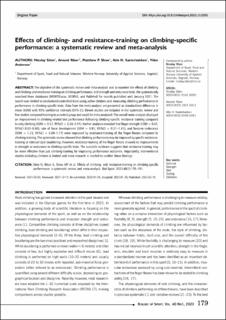| dc.contributor.author | Stien, Nicolay | |
| dc.contributor.author | Riiser, Amund | |
| dc.contributor.author | Shaw, Matthew Peter | |
| dc.contributor.author | Sæterbakken, Atle Hole | |
| dc.contributor.author | Andersen, Vidar | |
| dc.date.accessioned | 2023-09-08T08:34:16Z | |
| dc.date.available | 2023-09-08T08:34:16Z | |
| dc.date.created | 2023-06-01T16:23:20Z | |
| dc.date.issued | 2023 | |
| dc.identifier.citation | Biology of Sport. 2023, 40 (1), 179-191. | en_US |
| dc.identifier.issn | 0860-021X | |
| dc.identifier.uri | https://hdl.handle.net/11250/3088145 | |
| dc.description.abstract | The objective of this systematic review and meta-analysis was to examine the effects of climbing and climbing-and-resistance-training on climbing performance, and strength and endurance tests. We systematically searched three databases (SPORTDiscus, SCOPUS, and PubMed) for records published until January 2021. The search was limited to randomized-controlled trials using active climbers and measuring climbing performance or performance in climbing-specific tests. Data from the meta-analysis are presented as standardized difference in mean (SDM) with 95% confidence intervals (95% CI). Eleven studies are included in the systematic review and five studies compared training to a control group and could be meta-analyzed. The overall meta-analysis displayed an improvement in climbing-related test performance following climbing-specific resistance training compared to only climbing (SDM = 0.57, 95%CI = 0.24–0.91). Further analyses revealed that finger strength (SDM = 0.41, 95%CI 0.03–0.80), rate of force development (SDM = 0.91, 95%CI = 0.21–1.61), and forearm endurance (SDM = 1.23, 95%CI = 0.69–1.77) were improved by resistance-training of the finger flexors compared to climbing training. The systematic review showed that climbing performance may be improved by specific resistance training or interval-style bouldering. However, resistance-training of the finger flexors showed no improvements in strength or endurance in climbing-specific tests. The available evidence suggests that resistance-training may be more effective than just climbing-training for improving performance outcomes. Importantly, interventional studies including climbers is limited and more research is needed to confirm these findings. | en_US |
| dc.language.iso | eng | en_US |
| dc.publisher | Termedia | en_US |
| dc.rights | Navngivelse-DelPåSammeVilkår 4.0 Internasjonal | * |
| dc.rights.uri | http://creativecommons.org/licenses/by-sa/4.0/deed.no | * |
| dc.title | Effects of climbing- and resistance-training on climbing-specific performance: a systematic review and meta-analysis | en_US |
| dc.type | Peer reviewed | en_US |
| dc.type | Journal article | en_US |
| dc.description.version | publishedVersion | en_US |
| dc.rights.holder | © Institute of Sport – National Research Institute, Warsaw, Poland | en_US |
| dc.source.pagenumber | 179-191 | en_US |
| dc.source.volume | 40 | en_US |
| dc.source.journal | Biology of Sport | en_US |
| dc.source.issue | 1 | en_US |
| dc.identifier.doi | 10.5114/biolsport.2023.113295 | |
| dc.identifier.cristin | 2150957 | |
| cristin.ispublished | true | |
| cristin.fulltext | original | |
| cristin.qualitycode | 1 | |

